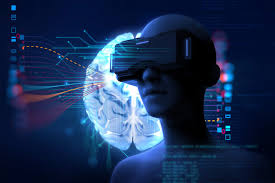Virtual Reality for Therapy: Exploring the New Frontiers in Mental Health Treatment
Mental health issues are a growing concern around the world, and with the ongoing pandemic, the need for mental health services has become even more critical. In recent years, virtual reality (VR) has emerged as a promising tool for treating various mental health conditions. Virtual reality therapy has proven to be an effective treatment approach for conditions such as anxiety disorders, post-traumatic stress disorder (PTSD), phobias, and depression. In this article, we will explore the new approaches to virtual reality therapy and how they are changing the mental health landscape.
Virtual reality therapy is a form of psychotherapy that uses VR technology to create simulated environments that allow patients to confront their fears and anxieties in a controlled setting. Unlike traditional exposure therapy, where patients are gradually exposed to the source of their fears in real-life situations, virtual reality therapy allows patients to confront their fears in a safe and controlled environment. Virtual reality therapy can also be used to create positive environments that can help patients build new coping skills and develop healthier thought patterns.
One of the most significant advantages of virtual reality therapy is its ability to create a sense of presence in patients, which can enhance treatment outcomes. The sense of presence is the feeling of being present in the virtual environment, as if it were real. This feeling can help patients to immerse themselves in the therapy experience and engage more fully in the treatment process. Virtual reality therapy can also provide patients with a sense of control, which can be empowering for individuals who feel overwhelmed by their mental health condition.

Virtual reality therapy is becoming increasingly popular for treating anxiety disorders, which are among the most common mental health conditions globally. Virtual reality therapy for anxiety disorders involves creating simulations that expose patients to their fears and anxieties in a controlled environment. For example, virtual reality therapy can be used to treat social anxiety by simulating social situations, such as public speaking, job interviews, or dating scenarios. Patients can learn to manage their anxiety by practicing coping skills in the virtual environment, which can then be applied to real-life situations.
Virtual reality therapy is also proving to be an effective treatment approach for PTSD. PTSD is a mental health condition that affects individuals who have experienced or witnessed traumatic events. Symptoms of PTSD can include flashbacks, nightmares, and feelings of anxiety and depression. Virtual reality therapy for PTSD involves recreating the traumatic event in a virtual environment, allowing patients to confront their memories and emotions in a controlled setting. This type of therapy can help patients to process their traumatic experiences and develop coping strategies to manage their symptoms.
Another area where virtual reality therapy is showing promise is in the treatment of phobias. A phobia is an intense fear of a specific object or situation that can interfere with a person’s daily life. Virtual reality therapy for phobias involves creating simulations of the feared object or situation, allowing patients to gradually confront their fears in a safe and controlled environment. This type of therapy can help patients to overcome their phobias and develop coping strategies to manage their symptoms.
Virtual reality therapy is also being used to treat depression, which is a mental health condition that affects millions of people worldwide. Depression can cause feelings of sadness, hopelessness, and loss of interest in activities that patients once enjoyed. Virtual reality therapy for depression involves creating positive environments, such as a beach or forest, where patients can practice mindfulness and relaxation techniques. This type of therapy can help patients to improve their mood and reduce their symptoms of depression.
In recent years, new approaches to virtual reality therapy have emerged that are changing the mental health landscape. One of these approaches is the use of virtual reality gaming technology to deliver therapy. Virtual reality gaming technology is a rapidly growing industry, and the immersive nature of gaming technology can be used to enhance therapy outcomes. For example, virtual reality gaming technology can be used to create engaging and interactive therapy experiences that can help patients to build new coping skills and develop healthier thought patterns. Games can be designed to challenge patients to confront their fears and anxieties in a safe and controlled environment, while also providing a fun and engaging experience.
Another new approach to virtual reality therapy is the use of biofeedback technology. Biofeedback technology allows patients to monitor their physiological responses, such as heart rate and breathing, in real-time. Virtual reality therapy using biofeedback technology can help patients to develop self-regulation skills by providing real-time feedback on their physiological responses to stressors. This type of therapy can help patients to learn to manage their anxiety and stress levels by teaching them how to control their physiological responses to stressors.
Virtual reality therapy is also being used to treat eating disorders, such as anorexia and bulimia. Eating disorders are complex mental health conditions that can have serious physical and emotional consequences. Virtual reality therapy for eating disorders involves creating simulations that allow patients to confront their fears and anxieties around food and body image in a safe and controlled environment. Patients can practice coping strategies and learn to challenge negative thought patterns that contribute to their eating disorder.

Conclusion
Virtual reality therapy is a promising new approach to mental health treatment that is changing the way we think about psychotherapy. Virtual reality therapy can be used to treat a range of mental health conditions, including anxiety disorders, PTSD, phobias, and depression. The ability to create a sense of presence in patients and provide a safe and controlled environment for exposure therapy can enhance treatment outcomes. New approaches to virtual reality therapy, such as virtual reality gaming technology and biofeedback technology, are expanding the possibilities for mental health treatment. As the technology continues to evolve, virtual reality therapy has the potential to become an increasingly effective and accessible form of mental health treatment for people around the world.





















